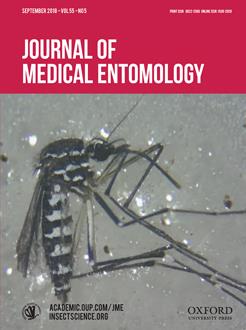Ultraviolet (UV) radiation is a key limiting factor for biological pest control with entomopathogenic fungi. While little is known about the impact of UV on Metarhizium anisopliae Metchnikoff (Sorokin) (Hypocreales: Clavicipitaceae) conidia in aquatic mosquito-breeding sites, this study determined the effect of UV-B on the viability and virulence of M. anisopliae sensu lato (s.l.) strain IP 46 in the laboratory against Aedes aegypti (L.) (Diptera: Culicidae) larvae. Conidia were treated in cups under defined water depths (0, 1, 2, and 3 cm) to six different UV-B doses (0, 0.657, 1.971, 3.942, 7.884, 11.826, or 15.768 kJ m-2) at 27 ± 2°C. The ability of treated conidia to germinate up to 24 h postexposure on PDAY + benomyl + chloramphenicol medium at 25 ± 1°C was adversely affected by higher doses of UV-B radiation regardless of the water depth. Germination, however, did not fall below 70% regardless of the test conditions. In fact, conidial virulence against second-instar larvae was not affected by either the water depth (F3,84 = 0.3, P = 0.85) or any tested levels of UV-B radiation (F6,21 ≤ 1.2, P ≥ 0.39) including those distinctly higher than might be expected for tropical sites. These findings strengthen previous observations that IP 46 has significant potential for use against A. aegypti larvae, even when exposed to elevated UV-B irradiance levels in the small breeding sites that are common for this important vector.
BioOne.org will be down briefly for maintenance on 12 February 2025 between 18:00-21:00 Pacific Time US. We apologize for any inconvenience.
How to translate text using browser tools
10 May 2018
Effect of UV-B Irradiation on Water-Suspended Metarhizium anisopliae s.l. (Hypocreales: Clavicipitaceae) Conidia and Their Larvicidal Activity in Aedes aegypti (Diptera: Culicidae)
Marianel L. Falvo,
Patricia Albornoz Medina,
Juscelino Rodrigues,
Claudia C. López Lastra,
Juan J. García,
Éverton K.K. Fernandes,
Christian Luz
ACCESS THE FULL ARTICLE
It is not available for individual sale.
This article is only available to subscribers.
It is not available for individual sale.
It is not available for individual sale.

Journal of Medical Entomology
Vol. 55 • No. 5
September 2018
Vol. 55 • No. 5
September 2018
entomopathogenic fungus
germination
mosquito
UV-B tolerance
water level




